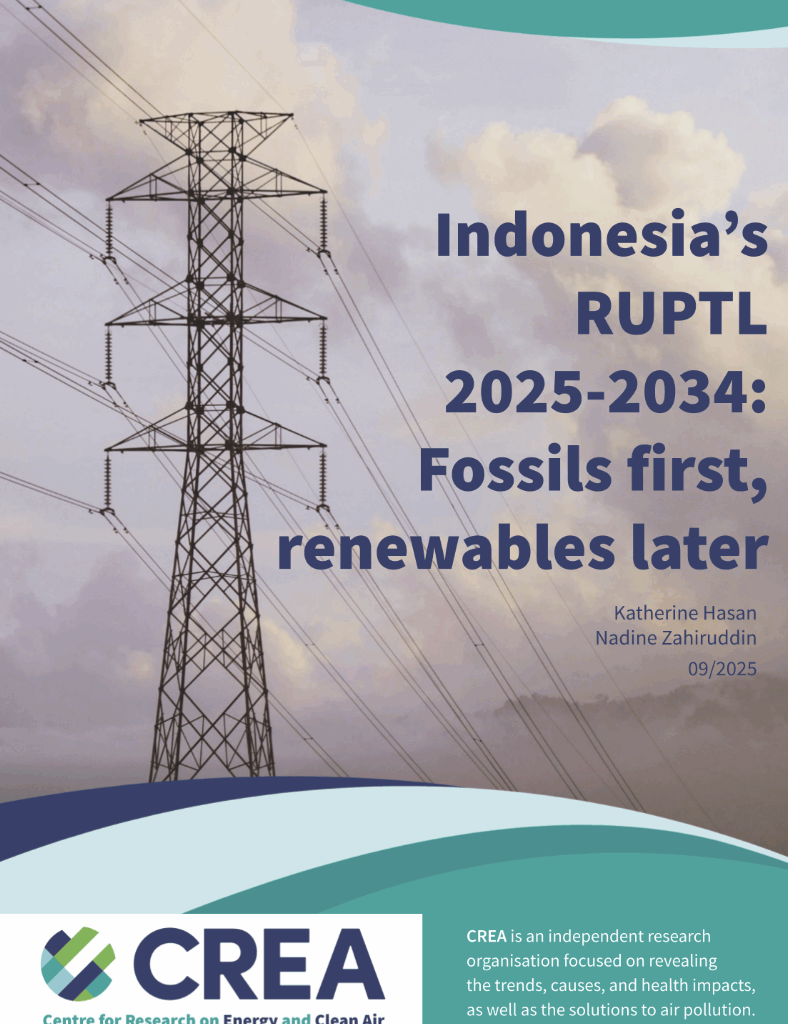🇮🇩 Versi Bahasa Indonesia tersedia di bawah
Following the publication of Indonesia’s ten-year power grid plan, RUPTL 2025-2034, CREA has published an in-depth report that reveals that, despite recent declarations that the country will transition to 100% renewable energy in a decade, renewables have not been given priority in this latest plan.
Indonesia’s RUPTL 2025-2034 10-year power grid plan continues the rapid expansion of fossil power generation with 16.6 GW coal and gas power capacity in the pipeline, and renewables capacity is less ambitious than the previous RUPTL 2021-2030. RUPTL 2025-2034 lowers Indonesia’s targeted 2030 renewable power capacity from 20.9 GW to 18.6 GW. This decision undercuts Indonesia’s ambitions, by leaving major hurdles unresolved — the same financial and regulatory hurdles that caused significant shortfalls in the implementation of RUPTL 2021-2030.
Although RUPTL 2025-2034 projects a quadrupling of clean energy production by 2034, from 44 TWh to 172 TWh, a 40% jump in fossil fuel power generation is planned in the same period, from 295 TWh to 407 TWh. These targets fall significantly short of the climate-aligned targets for on-grid power generation in Indonesia’s Just Energy Transition Partnership (JETP), which envisions over a nine-fold increase in renewable energy by 2034, and a 16% decrease in fossil-based electricity.
Renewables investment remains critically low at USD 565 million in the first half of 2024, less than a quarter of the USD 2.4 billion directed to the mineral and coal sector. Renewable energy deployment in RUPTL 2025-2034 is also delayed until after 2030, contrary to initial JETP commitments for peak emissions before 2030, and a 1.5-degree scenario pathway, which risks entrenching the country in dated fossil fuel infrastructure. The sole state-owned power company, PLN, has actively pursued the expansion of fossil fuel based capacity and has not been willing to implement earlier targets for renewable energy expansion, or address coal phase-out.
Even so, in August 2025, key ministers under Prabowo’s cabinet announced a plan to install 100 GW of solar power, with most of the capacity distributed in over 80,000 villages through a cooperative network called Koperasi Desa Merah Putih (KDMP), which would be a gamechanger.
To turn this vision into reality, the administration must address the disconnect with current national targets and modernize the grid outside of Java to support a rapid, unprecedented scale of renewable energy deployment. A detailed public roadmap and clear integration with existing national power plans, such as the RUPTL, would be the first key step in realising this project.
Policy recommendations
Realign national planning with local potential and climate commitments – The RUPTL must explicitly incorporate and prioritise the vast renewable energy potential identified in provincial planning, ensuring alignment between RUPTL and RUEDs. This would require revisiting the near-term renewable energy capacity additions, which should be strengthened by aligning them with JETP CIPP’s 2030 targets and a 1.5-degree scenario pathway. This means accelerating solar, wind, and dispatchable renewables deployment across all suitable regions, beyond just Java-Bali.
Firmly commit to accelerated coal phase-out – The Ministerial Regulation No. 10 Year 2025 must be revised to provide a clearer, more obligatory framework with specific criteria and a transparent, independent assessment process for candidate power plants, minimizing PLN’s conflict of interest. In parallel, stakeholders need to seek strategies to renegotiate take-or-pay clauses to manage overcapacity and allow room for new renewables to grow. To truly prioritise renewables, the RUPTL should no longer include fossil power additions beyond absolute requirements for grid stability.
Create a level playing field for RE investment and grid decentralisation – Fundamental policy reform that streamlines permitting processes, and sets attractive mechanisms to unlock private sector investment, is key in ensuring RE targets in PLN’s RUPTL and RUED can be achieved. The central government should ensure PLN and regional governments are supported in RE implementation through issuance of facilitating regulations. PLN should also evolve into a more efficient, reliable buyer and grid operator, with a core mandate to seamlessly integrate decentralised renewable energy across Indonesia’s vast archipelago.

